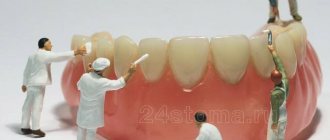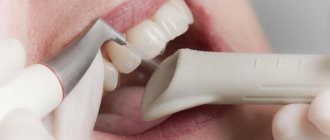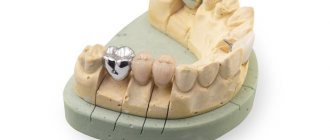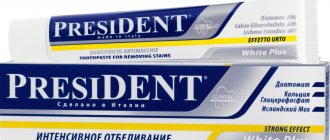How long can you wear without taking it off?
How to store? How to care? Whitening dentures Service life Dentures for many years You can restore the dentition in different ways, including removable dentures. They help restore the beauty of a smile, restore chewing function, and increase self-esteem. In order for restorations to retain their attractive appearance and last for several years, they must be looked after. Cleaning dentures and disinfecting them is an important part of care.
After installation, the dentist will definitely give recommendations on how to use dentures. He will warn that in the first days the restoration will interfere. It is necessary to prepare yourself psychologically and survive this time. It will become easier in a few days. Usually the hardest day is the first. Then a difficult 5-7 days
addictive, but they are not so intense. During this period, orthopedists advise not to remove the denture at night and generally remove it from the mouth only for cleaning.
These days, the patient practices his skills of taking off and putting on dentures, speaking when the tongue is cramped in the mouth, and chewing with unusually high teeth.
How long can you wear a prosthesis without removing it?
It is believed that the adaptation period has come to an end when the patient without dentures becomes uncomfortable. He already knows how to quickly put them on, they do not interfere with speaking, and are involved in chewing food. The period when it is better not to remove the structure is ending. Now you can take it out, but how often?
The standard recommendation is to remove the dentures at night to give your gums a chance to rest. If the denture is not removed, the hygienic condition of the oral cavity deteriorates. However, modern dentistry is characterized by an individual approach, so how often to remove dentures depends on specific circumstances. For example, with removable prosthetics, it is important how many antagonist teeth remain. In some cases, a prosthesis helps protect the remaining teeth from traumatic occlusion (touch) and overstrain. Do not remove splinted structures or restorations due to arthropathy and bruxism
[1].
The side effects of restoration can be compensated for by using prosthetic products without a palate and frequent cleaning.
Basic rule:
The less often the patient removes the prosthesis, the more carefully it needs to be looked after.
Methods of fastening the clasp
Several varieties of clasp-type products have been developed, which differ from each other not only in the material of manufacture, but also in the method of attachment to living teeth or implants.
The following types of fastening the structure in the oral cavity are distinguished:
- On clasps. This type of fastener consists of metal hooks that hook onto supports at the base. When using this design, there is no need to grind the teeth. This variety is inferior in aesthetic characteristics, since hooks can catch the eye when talking or smiling.
- On attachments. This type of fastening is a locking design and consists of 2 parts. One of them is fixed on a ground tooth or implant, and the second is fixed on a prosthesis. When fixing the device in the oral cavity, the 2 parts of the fastening snap together. This variety is distinguished by reliable fixation and uniform distribution of load while chewing food. This model is more expensive compared to the previous one.
- On telescopic crowns. When using such a system for fixing the device, permanent crowns are put on living supports, and the prosthetic crowns are installed on them. This method of fixing the dental apparatus is distinguished by high aesthetic indicators and the degree of reliability of fastening. The disadvantage is its high cost, which limits its distribution.
Each of these structures requires its own approach to storage and repair.
Foods to avoid
Proper care of dentures also means that you need to treat them with care. During the first time after installation, patients have to slightly change their diet. Although most foods will gradually return to your diet, some of them should be abandoned altogether. These are solid products: crackers, nuts, seeds, dried bread and bagels. Classified as unwanted
include toffee, nougat, and chewing gum. It is better to avoid food that is too hot to prevent cracks in the base.
At first, it is better not to bite off anything at all, then bite off with the side group of teeth, gradually moving to the front group.
It is important to chew food slowly, making sure that the chewing load is distributed evenly on both sides.
Tea, coffee, red wine and dark berries create conditions for discoloration of restorations. This should also be kept in mind when choosing drinks and food.
This is especially true for acrylic plastics. They are permeated with micropores in which pigments easily accumulate. More modern materials such as Acry Free or QuattroTi are dye resistant.
Immediate
Replace a unilateral included defect. The design can be created from any materials used in dentistry. Capable of restoring a row of holes. Also found under the name "butterflies".
Several artificial crowns are attached to a miniature base, secured with hooks and locks. Recommended as a temporary solution after removal of diseased masticatory organs.
For those who are going to install metal ceramics and do not have enough money, it helps to gain time to collect them. Some patients use it all their lives, replacing it with a new one after a few years.
How to store
The best place to store dentures is in a special container. As a last resort, you can put it in a glass of water or wrap it in a damp cloth. To store dentures at night and between uses:
- away from children and animals;
- in a special solution or cooled boiled water. Do not immerse in boiling water or tap water, which contains many impurities.
Whether to place the product in water or a special storage solution largely depends on the material
. Modern thermoalloys do not need a humid environment, but classic acrylic ones can dry out without water. Your dentist will advise you on how to properly store dentures, taking into account the material of construction.
How to care for dentures
A side effect of removable dentures is a change in the microflora of the oral cavity. Because of the prosthesis, the palate and gums stop cleaning themselves. Bacteria accumulate in the mouth, especially at the points of attachment to the crown of the tooth, if the structure is partial. The longer a restoration is used, the more it is exposed to biocontamination.
Proper care has a great impact on the service life of removable structures. It is multi-stage, but in reality it does not require much time and effort.
In dentistry, there are mechanical, chemical, and physical methods of cleaning restorations.
Mechanical cleaning
carried out with a special toothbrush. The fact that it has bristles on both sides helps to effectively clean removable dentures from plaque. The longer one is for processing the outside, and the short one is for the inside. The heads are either straight or crescent-shaped.
An orthopedic dentist will definitely tell you how to clean your dentures. The brush should be soft, usually written “soft” on the packaging, and the paste should be low-forming. The abrasiveness coefficient is indicated on the packaging under the letter RDA
.
For nylon and Acry Free bases, it is best to choose a paste with zero abrasiveness
. These are produced for children under 3 years of age. Instead of toothpaste, you can use liquid soap.
Acrylic bases can be cleaned with a paste with an abrasiveness of up to 25
. For ordinary pastes, this coefficient is 60 or higher. Whitening pastes are not recommended.
Chemical cleaning
- This is soaking in disinfectant solutions. The structure is immersed in the prepared solution or a special tablet is added to the water. Such products are sold in pharmacies. The most famous brands: Corega and Protefix. These products destroy bacterial plaque, which can cause diseases of the mucous membrane and cause an unpleasant odor from the prosthesis. After being in the solution, the structure emits a pleasant aroma.
However, in case of heavy contamination, such disinfection does not provide 100% cleaning. If a layer of pigment or tartar has formed on the product, home care tablets for removable plastic dentures will not help. Here they use polishing at the dentist or ultrasound.
Physical cleaning
Ultrasound is suitable for complete dentures made of any material. Ultrasound passes through the liquid, creating bubbles on the surface of the restoration, which, when bursting, help clear plaque on the dentures, clean them of food debris and dirt, even from hard-to-reach places. 10-20 minutes in such a bath and not a trace remains of bacterial plaque. The higher the power of the ultrasonic bath, the better it cleans the surface.
After each meal, it is recommended to rinse the restoration under running water. The cleaner the denture, the more comfortable it feels in the mouth. A structure covered with plaque and stains wears out faster. In addition, dirt and bacterial film provoke inflammatory processes in the oral cavity. With proper and regular use of cleaning products, restorations retain their attractive appearance for a long time.
If the structure has become dull and shows signs of pigmentation, you can contact your dentist and he will send the denture for polishing.
What problems arise when stored incorrectly?
If you do not know how to properly store removable dentures, or do not follow the already known storage rules, the following problems may arise:
- deformation due to prolonged exposure to liquid,
- deformation due to overheating or hypothermia,
- overdrying negatively affects the performance properties of materials: microcracks and detachments may appear (where food debris will become clogged),
- the appearance of pigment spots, bacterial film and growths due to careless care or storage in unsuitable conditions,
- chips and cracks due to falls and systematic mild mechanical impacts (when shaking in a large container).
Whitening dentures
Pigmentation and brown deposits can ruin the appearance of any restoration. Regular oral care with dentures prolongs the life of the dentures and maintains the aesthetics of the structure. But whitening pastes only cause harm. They contain too many abrasives that scratch the plastic. The surface of artificial teeth is not as strong as that of natural teeth and is easily damaged.
The acids in home whitening kits are simply dangerous. The reaction of their components with prosthetic materials can lead to unpredictable, life-threatening results.
To whiten dentures at home, it is better to use special products. For example, Corega whitening tablets. They carefully clean the surface without harming it, eliminate unpleasant odors and remove stains. The tablets slightly lighten artificial teeth, simultaneously destroying pathogenic microflora,
Life time
If you wear your denture correctly and take good care of it, it will retain its original appearance for a long time. But after a maximum of 5 years
it will still have to be changed. This is due to the fact that removable dentures do not stop bone loss. Over the years, the gums sag, the topography of the mouth changes and the prosthesis no longer fits. In the first years, correction and relining help, but over time, the changes become so pronounced that only a new prosthesis can save the situation.
Design Features
Clasp-type dentures are used to replace teeth in both the upper and lower rows. The main distinguishing feature of this type of product is the presence of an arc, which can be made of either plastic or metal.
This device includes artificial gums and crowns attached to them. The prosthesis has a fixation system, which consists of hooks, locks or crowns that are connected to each other according to the principle of a telescope.
This type of prosthesis is used in cases where dental implantation is not possible. To use the structure, the dentition must contain at least 5-7 natural teeth or implants on which the prosthesis is fixed. This form of the device is not suitable in case of complete edentia.










